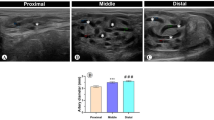Summary
The highly coiled testicular artery within the bovine spermatic cord has a constant luminal diameter but a continuously decreasing mural thickness. The pampini form plexus is composed of three interconnected venous networks differing in mesh sizes and calibres. The large veins of the first network display pouches and permanent constrictions, which may serve as throttle devices. The constitutents of the third network are venules or venous capillaries with diameters between 10 and 20 μm; they favor a periarterial position or even occupy the media-adventitia border of the testicular artery. All plexus veins are devoid of valves. The existence of true arteriovenous anastomoses between smaller branches of the testicular artery and plexus veins was established by serial sections. The vascular morphology of the spermatic cord is discussed with special attention to a postulated venous-arterial steroid transfer in this region.
Similar content being viewed by others
References
Amann RP, Ganjam VK (1976) Steroid production by the bovine testis and steroid transfer across the pampiniform plexus. Biol Reprod 15:695–703
Bayard F, Boular PY, Huc A, Pontonnier F (1975) Arterio-venous transfer of testosterone in the spermatic cord of man. J Clin Endocrinol Metabol 40:345–346
Damber JE, Tomic R, Bergmann B, Bergh A (1979) Increased concentration of testosterone in testis artery blood as compared to peripheral venous blood in man. Int J Androl 2:315–318
Free MJ (1977) Blood supply to the testis and its role in local exchange and transport of hormones. In: Johnson AD, Gomes WR (eds) The testis, Academic Press, New York San Francisco London, vol. IV, pp 39–90
Hofmann R (1960) Die Gefäßarchitektur des Bullenhodens, zugleich ein Versuch ihrer funktionellen Deutung. Zbl Vet Med 7:59–93
Kohler T, Leiser R (1983) Blood vessels of the bovine chorioidea. Acta Anat 116:55–61
Krzymowski T, Kotwica J, Stefancyk S, Czarnocki J, Debek J (1982) A subovarian exchange mechanism for the countercurrent transfer of ovarian steroid hormones in the pig. J Reprod Fertil 65:457–465
Leiser R, Kohler T (1983) The blood vessels of the cat girdle placenta, observations on corrosion casts, scanning electron microscopical and histological studies, I: Maternal vasculature. Anat Embryol 167:85–93
Scheubeck M, Wrobel KH (1983) Eine einfache transportable Apparatur zur Durchführung von Perfusionsfixierungen. Mikroskopie (in press)
Wrobel KH, Sinowatz F, Kugler P (1978) Zur funktionellen Morphologie des Rete testis, der Tubuli recti und der Terminalsegmente der Tubuli seminiferi des geschlechtsreifen Rindes. Zbl Vet Med C Anat Histol Embryol 7:320–335
Wrobel KH, Sinowatz F, Mademann R (1982) The fine structure of the terminal segment of the bovine seminiferous tubule. Cell Tissue Res 225:29–44
Author information
Authors and Affiliations
Additional information
Supported by the Deutsche Forschungsgemeinschaft and the Stiftung zur Förderung der wissenschaftlichen Forschung an der Universität Bern
Rights and permissions
About this article
Cite this article
Hees, H., Leiser, R., Kohler, T. et al. Vascular morphology of the bovine spermatic cord and testis. Cell Tissue Res. 237, 31–38 (1984). https://doi.org/10.1007/BF00229196
Accepted:
Issue Date:
DOI: https://doi.org/10.1007/BF00229196




